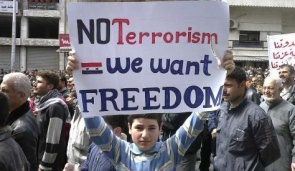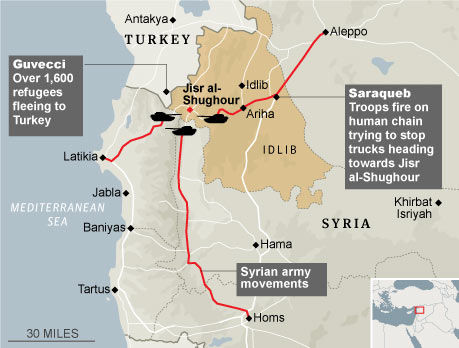
Syrian troops backed by tanks tightened their grip on the town of Jisr al-Shughour Saturday as they pressed ahead with an effort to regain control over a swath of territory in northern Syria that appeared to have fallen out of government control.
The offensive against the northern rural town on Friday came as tens of thousands of Syrians took to the streets around the country yet again to call for the ouster of President Bashar al-Assad, in a further sign that the government’s use of overwhelming force is not only failing to crush a swelling tide of discontent, but perhaps helping to fuel the unrest.
At least 34 people were killed, according to Wissam Tarif of the human rights group Insan, including at least 19 who died in the northern province of Idlib as the Syrian army swept through villages toward Jisr al-Shughour, near the Turkish border. The others died when troops opened fire on protesters staging demonstrations in towns elsewhere, he said.
 An eyewitness in Jisr al-Shughour said around 2,000 officers and conscripts had defected from the Syrian army and were fighting alongside residents in the town to repel the assault. “They mutinied because of their orders” to shoot at local civilians, he said, speaking on the condition of anonymity because he feared the consequences of talking to the news media.
An eyewitness in Jisr al-Shughour said around 2,000 officers and conscripts had defected from the Syrian army and were fighting alongside residents in the town to repel the assault. “They mutinied because of their orders” to shoot at local civilians, he said, speaking on the condition of anonymity because he feared the consequences of talking to the news media.
His account could not be independently confirmed, but if true, it would signify the biggest number of defections in the Syrian army yet. There have been scattered reports in the past of soldiers fleeing their units after refusing to carry out orders to shoot civilians, but none has yet added up to a mutiny on a scale that would threaten the government’s survival.
Syrian government spokeswoman Reem Haddad denied that there had been significant defections and said she was aware of only one officer, who gave an interview earlier in the day on the al-Jazeera network. “The army is the backbone of Syria, the backbone of the government,’’ she said.
She said troops had been dispatched to the area after “armed groups” seized control and began terrorizing residents, prompting an exodus to Turkey of at least 4,000 people.
The conflicting narratives illustrate the difficulty of establishing what is really happening in Syria given that most journalists have been denied access to the country. They also display the growing polarization between a government intent on using force to survive and a populace increasingly intent on toppling it.
Troops launched the offensive after the reported deaths of 120 Syrian soldiers in an ambush earlier this week. Although that number, cited by Syrian state media, cannot be confirmed, it does appear that the 12-week uprising against the Syrian government is taking a violent turn in this corner of the country, an area with a long history of dissent. Activists say the soldiers were killed by their officers for refusing to fire on civilians.
The push into Jisr al-Shughour capped a day of bloodshed in the surrounding villages in which human rights groups said at least 19 people were killed. According to Wissam Tarif of the human rights group Insan, most of the deaths came when troops opened fire on protesters in the town of Khan Sheikhun in Idlib province where there were numerous reports of anti-government demonstrations despite the heavy troop presence.
In another town, Maarat al-Nouman, where human rights activists said three people were shot dead, the government accused protesters of setting fire to buildings.
The White House condemned the violence, with press secretary Jay Carney saying, “There must be an immediate end to the brutality.”
By no means has all of the country turned against the government, but the numbers that turn out to protest repeatedly every Friday suggest that the security forces are still a long way from quelling the unrest.
Perhaps most worrisome for the government, Small demonstrations were staged for the first time Friday in the northern town of Aleppo, Syria’s biggest city and its economic capital, whose mostly Sunni merchant class has refrained from taking to the streets. Activists said there were small protests in six Aleppo neighborhoods.
“The government is confused. They don’t know what to do,” said Razan Zeitouneh, a human rights lawyer who is in hiding in Damascus. “Each time they use violence, more people turn out to protest, and they are all calling for the regime to end.”
In another sign of possible disarray, security forces pulled out of the town of Hama overnight Thursday, allowing tens of thousands of protesters to overwhelm the city’s central Assi Square.
Last Friday, troops killed 67 protesters in the town in one of the single worst incidents of the uprising.
This Friday, there were “no security forces present at all,” said a witness in the town, who spoke by telephone on the condition of anonymity. “We are all in the square and we will stay here until midnight and then we will come back tomorrow.”
Watch this video of an officer who defected
WP
Leave a Reply
You must be logged in to post a comment.